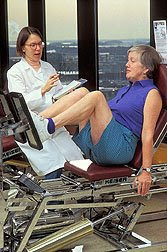Autism - Hyperbaric Oxygen Chamber Therapy
Hyperbaric Oxygen Chamber Therapy and Autism - Recently, hyperbaric oxygen therapy (HBOT) has increased in popularity as a treatment for autism.
Numerous studies document oxidative stress and inflammation in individuals with autism; both of these conditions have demonstrated improvement with hyperbaric oxygen therapy, along with enhancement of neurological function and cognitive performance.
In this study, children with autism were treated with hyperbaric oxygen therapy at atmospheric pressures and oxygen concentrations in current use for this condition. Changes in markers of oxidative stress and inflammation were measured. The children were evaluated to determine clinical effects and safety.
In some studies, the use of oxygen appears to enhance neurological function. For instance, in a double-blind, placebo-controlled, cross-over study, oxygen administration in healthy young adults, when compared to room air, was demonstrated to enhance cognitive performance, including improved performance on attention, reaction times, and word recall. (Psychopharmacology (Berl) 1998, 138(1):27-33).
Additionally, in elderly patients, hyperbaric oxygen therapy (HBOT) at 2.5 atm and 100% oxygen, when compared to a control group, improved cognitive function, including memory. (N Engl J Med 1969, 281(14):753-757).
Because of these outcomes, some investigators have used HBOT to treat certain neurological disorders, including chronic and traumatic brain injury, as well as fetal alcohol syndrome, and clinical improvements in these patients have been observed.
Hyperbaric oxygen therapy for children is generally regarded as safe, even at pressures of 2.0 atm for 2 hours per day. However, to our knowledge, the safety of HBOT for autistic children has not been previously studied; a review of MEDLINE indicates that there are no prospective studies on the use of hyperbaric oxygen therapy for autism.
Yet, there are anecdotal reports of clinical improvements in autistic children with hyperbaric therapy that have been reported by some physicians.
For instance, Heuser et al. treated a four year old child with autism using hyperbaric therapy at 1.3 atm and 24% oxygen and reported “striking improvement in behaviour including memory and cognitive functions” after only ten sessions.
This child also had marked improvement of cerebral hypoperfusion as measured by pre-hyperbaric and post-hyperbaric Single Photon Emission Computed Tomography (SPECT) scans.
Another case series suggested that hyperbaric therapy at 1.3 atm led to clinical improvements in six autistic children. (Med Hypotheses 2006, 67(2):216-228).
However, the effects of hyperbaric oxygen therapy on oxidative stress in autistic individuals are unknown. To our knowledge, there have been no studies performed which examine the role of hyperbaric oxygen therapy on oxidative stress in autistic children.
This present study examined hyperbaric therapy at the low and the high ends of the ranges of atmospheric pressures and oxygen concentrations currently employed in individuals with autism: 1.3 atm and 24% oxygen, and 1.5 atm and 100% oxygen.
This study had several objectives. First, since increased oxidative stress is found in some autistic children, the effects of hyperbaric oxygen therapy (HBOT) on oxidative stress markers before and after 40 hyperbaric treatments were measured. Second, evidence of increased inflammation is found in many autistic individuals.
HBOT is also known to have anti-inflammatory effects; therefore, the impact of hyperbaric oxygen therapy on an inflammatory marker (C-reactive protein) was measured.
Third, since the efficacy of hyperbaric oxygen therapy in autism has not been previously evaluated, this current open-label pilot study (without a placebo control group) examined the changes in clinical symptoms, as rated by parents or caregivers, after treatment with hyperbaric oxygen therapy.
Finally, the safety of HBOT, used at 1.3 and 1.5 atm, was evaluated in autistic children.
Eighteen children with autism, ages 3-16 years, underwent 40 hyperbaric sessions of 45 minutes duration each at either 1.5 atmospheres (atm) and 100% oxygen, or at 1.3 atm and 24% oxygen.
Measurements of C-reactive protein (CRP) and markers of oxidative stress, including plasma oxidized glutathione, were assessed by fasting blood draws collected before and after the 40 treatments. Changes in clinical symptoms, as rated by parents, were also assessed. The children were closely monitored for potential adverse effects.
This prospective open-label pilot study in children with autism indicates, as measured by changes in plasma oxidized glutathione, that hyperbaric oxygen therapy ranging from 1.3 to 1.5 atm and 24% to 100% oxygen was not significantly associated with increased intracellular oxidative stress.
The use of therapies to raise glutathione levels and lower oxidative stress before beginning hyperbaric oxygen therapy in individuals with autism appears prudent.
Among children with high initial C-reactive protein, hyperbaric therapy led to a large improvement in CRP levels; this suggests that inflammation in these children improved with treatment.
Parental observations support anecdotal accounts of improvement in several domains of autism.
Note: A report on CBS4 in Denver quoted Dr. Daniel Rossignol, the principal researcher of this study, as saying: "We've had more language, sometimes had new words, that type of thing, or (patients have) started putting more words into sentences. We also found improvements in cognition, which means their ability to think, focus ... that type of thing."
Related Articles:
Signs of Autism in Infants – Parents See Signs Long Before Professionals
References:
Extracted and adapted from: The effects of hyperbaric oxygen therapy on oxidative stress, inflammation, and symptoms in children with autism: an open-label pilot study. BMC Pediatrics 2007, 7:36 doi:10.1186/1471-2431-7-36.
© 2007 Rossignol et al., licensee BioMed Central Ltd.
This is an open access article distributed under the terms of the Creative Commons Attribution License (http://creativecommons.org/licenses/by/2.0).
http://cbs4denver.com/health/local_story_223173252.html
Disclaimer: The information contained in this article is presented for information purposes only and is in no way intended to replace professional medical care or attention by a qualified practitioner. It cannot and should not be used as a basis for diagnosis or choice of treatment.




 Is Starting a New Exercise Program Your New Years Resolution? - Struggling with your New Year's resolution to attend aerobics class five times a week, or run two miles a day?
Is Starting a New Exercise Program Your New Years Resolution? - Struggling with your New Year's resolution to attend aerobics class five times a week, or run two miles a day? The Benefits of Beta Carotene & Lutein – From Cancer to Macular Degeneration - Carotenoids are fat-soluble pigments responsible for many of the colorful hues of plant leaves, fruits, and flowers.
The Benefits of Beta Carotene & Lutein – From Cancer to Macular Degeneration - Carotenoids are fat-soluble pigments responsible for many of the colorful hues of plant leaves, fruits, and flowers.

